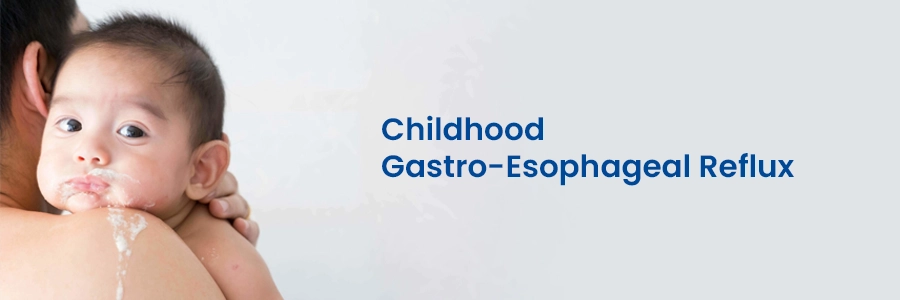Childhood Gastro-esophageal Reflux
Gastro-esophageal reflux is common in young children and babies. A small amount of milk regurgitation is common in every baby after feeding. This is most commonly caused by reflux. If there are no other symptoms, this regurgitation is harmless in young infants and does not need any treatment or investigation.
In premature babies and infants with low weight birth, Gastro-esophageal reflux is more common. It is also common in babies or children with impairment of muscles or nerves, like cerebral palsy or with cow milk allergy. Gastro-esophageal reflux occurs in both bottle-fed and breastfed babies as well.
Why does reflux occur?
Reflux occurs because of muscle relaxation at the lower end of the oesophagus. Because of this, some stomach contents pass into the oesophagus, causing vomiting or regurgitation. This can irritate the oesophagus lining as the stomach contents are acidic. If the reflux is associated with symptoms like poor weight gain, distressed behaviour, and crying, which are troublesome, then it is known as GERD (Gastro-esophageal Reflux Disease).
What are the reflux symptoms?
Gastro-esophageal reflux leads to vomiting and regurgitation due to some feeds, which is mostly associated with other symptoms.
This can include symptoms of baby colic like:
- Crying
- Drawing the legs up towards the abdomen
- Pain in the abdomen after a feed
- Blood in stools(uncommon)
- Refusing feeds
- Occasionally wheezing because of severe reflux
- Poor weight gain
Reflux symptoms in older children may include:
- Heat burn
- Foul taste
- Watery fluid into the mouth
Investigations for Gastro-esophageal reflux
Healthcare providers diagnose Gastro-esophageal reflux mostly by talking to parents or examining the baby, without any investigations required. Doctors may advise the parents to maintain a record of how much feed (fluid and food) the baby is having and how often the baby is bringing up the feed.
The doctor may advise a few more investigations if the reflux symptoms are severe.
The tests include:
Endoscopy
To diagnose any inflammation of the lining of the oesophagus and stomach, a small tube with a camera is inserted into the oesophagus.
Monitoring the pH of the oesophagus
A very small probe is inserted into the oesophagus to measure the amount of acid.
Barium Swallow
Nowadays, this test is not often performed. The test includes a barium drink and an X-ray.
Treatment for Gastro-esophageal reflux
In infants, regurgitation is harmless if it is not associated with other symptoms and it does not need any investigations or treatment.
Babies or children having reflux with no other symptoms and are otherwise well need no treatment. The condition improves after some time. Monitoring the weight of the baby or child is needed to ensure proper growth with appropriate weight. Reducing the amount of feed (food or fluid) and increasing the frequency of feeding (like feeding more times) may be beneficial sometimes.


